What Is the Difference Between Tube Axial and Vane Axial Fans
Tube axial and vane axial fans differ in design and performance, with vane axial fans providing higher pressure capabilities.
Read More
In the realm of cooling technology, two common devices often come to mind: fans and air coolers. While both serve the purpose of regulating temperature and promoting air circulation, they possess distinct characteristics and operate on different principles.
This blog post aims to delve into the intricacies of fans and air coolers, shedding light on their respective functionalities, advantages, and drawbacks.

An air cooler, also known as an evaporative air cooler or swamp cooler, is a cooling appliance that relies on the principle of evaporative cooling to lower the temperature of the surrounding air. Unlike traditional air conditioners that use refrigerants and compressors, air coolers employ water evaporation to provide a natural and energy-efficient cooling solution.
Air coolers operate by drawing hot, dry air from the environment and passing it through a wet filter or cooling pad. As the air moves through the damp honeycomb filter material, the water evaporates, absorbing heat from the air and lowering its temperature. The cooled air is then circulated back into the room using a powerful fan, creating a refreshing breeze that mimics the effects of a cool sea breeze.
The cooling process is regulated by a water pump that continuously moistens the cooling pad by drawing water from a built-in water tank. As the water evaporates, the tank needs to be refilled periodically to maintain optimal cooling performance.


A fan is a mechanical device designed to circulate air by rotating blades, creating a cooling effect through increased air movement. Unlike air coolers or air conditioners, fans do not actually lower the air temperature but instead provide a cooling sensation by accelerating the evaporation of sweat on the skin.
Fans operate by using an electric motor to spin a set of blades. As the blades rotate, they push air outwards, creating a breeze that circulates throughout the space.
When it comes to indoor cooling, fans and air coolers are two popular options. While both aim to provide relief from the summer heat, they have distinct differences in terms of cooling efficiency, cost, and noise levels.
When it comes to cooling larger spaces or dealing with extreme heat conditions, air coolers have an advantage over fans. Air coolers can lower the temperature of the outgoing air by several degrees, providing more effective temperature control. They are particularly useful in dry climates where the evaporative cooling process is most efficient.
However, it’s important to note that the cooling efficiency of air coolers depends on the humidity levels of the environment. In already humid climates, the evaporative cooling process is less effective, as the air is already saturated with moisture. In such cases, fans may be a more suitable option for improving air circulation and creating a cooling effect.
Fans are generally more affordable than air coolers, with prices ranging from budget-friendly desk fans to more expensive tower fans and ceiling fans. Fans have lower energy consumption compared to air coolers, making them a cost-effective cooling solution for smaller spaces or milder climates.
Air coolers tend to be more expensive than fans due to their additional features and cooling capabilities. While air coolers consume more energy than fans, they are still more energy-efficient than air conditioners. The evaporative cooling process used by air coolers requires less energy compared to the compressor and condenser units found in air conditioning systems.
Fans are generally quieter than air coolers, particularly at lower speed settings. The noise generated by fans comes from the rotating blades and the motor, which can be relatively unobtrusive, especially with modern, well-designed models.
Air coolers tend to produce more noise compared to fans. The noise is generated by the fan motor, the water pump, and the sound of the air passing through the cooling pads. Some air coolers may also produce a slight gurgling noise as the water circulates through the system.
No, an air cooler is not just a fan. While both devices move air, an air cooler also cools the air it circulates. It does this by passing air over water-soaked pads, causing the water to evaporate and cool the air. The cooled air is then blown out into the room.
An air cooler can cool a room, but not as effectively as an air conditioner. Air coolers work best in hot, dry climates where the air is not already saturated with moisture. They do not actually reduce the temperature of the room like an AC does, but rather provide a cooling effect through evaporation.